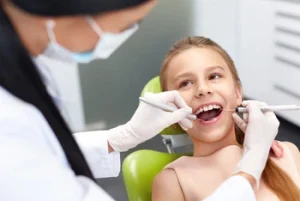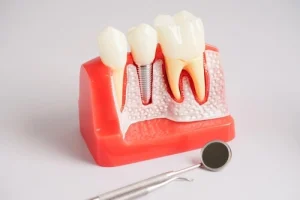A tooth breaking at the gum line can be alarming and painful, especially when an infection develops. It’s not just a cosmetic concern; it’s a serious dental emergency that can affect your surrounding teeth, gums, and overall oral health. Understanding what causes an infected tooth to break at the gum line and how to treat it promptly can prevent complications and save your smile.
How a Tooth Breaks at the Gum Line
A tooth broken at the gum line often results from severe decay, trauma, or structural weakness. When the remaining tooth structure becomes too fragile to withstand everyday pressure, it can fracture, leaving sharp edges that irritate the surrounding gum and soft tissues.
Common causes of a broken tooth
- Tooth decay: Cavities weaken enamel and dentin, increasing the risk of a tooth fracture.
- Gum disease: Advanced gum disease erodes the bone and tissues supporting your teeth, making them more likely to break.
- Contact sports or accidents: A sudden blow to the mouth can cause a broken molar or front tooth.
- Chewing hard foods: Biting into ice, nuts, or hard lollies can cause cracks or fractures.
- Large fillings: Teeth with extensive fillings are more prone to breaking under pressure.
Why Does Infection Develop in a Broken Tooth

If left untreated, an infected pulp may spread beyond the tooth, affecting the surrounding gum, bone, and even other parts of the body. The infection can also cause a tooth abscess, which is a pocket of pus that leads to severe pain and needs immediate dental attention.
Recognising the Symptoms of an Infected Broken Tooth
Recognising the early warning signs can help reduce the risk of developing serious complications. If you experience any of the following, see a dentist immediately:
- Throbbing or severe pain that radiates to the jaw or ear
- Swelling around the gum line or cheek
- Sensitivity to hot or cold foods
- Lingering unpleasant taste in the mouth or ongoing bad breath
- Redness and inflammation of the surrounding gum
- Fever or general malaise
- Visible tooth fracture with sharp edges or exposed root
Why Prompt Treatment Matters
When an infected tooth broken at the gum line is left untreated, bacteria can spread through the blood vessels into nearby tissues and bone. This may result in complications like bone deterioration, facial swelling, or the spread of infection throughout the body.
Prompt treatment helps prevent infection, protect the surrounding teeth, and restore function. Delaying treatment or overlooking symptoms can cause dental issues to worsen, often resulting in more extensive and expensive procedures down the line.
What to Do If Your Tooth Breaks at the Gum Line
A tooth breaking at the gum line can feel alarming, but knowing what steps to take immediately can make a big difference. Acting quickly helps protect the remaining tooth structure, prevent infection, and ease discomfort until you receive professional dental care.
Step 1: Seek emergency dental care
A broken tooth, especially one with infection, is a dental emergency. Contact a dental clinic or emergency dental care provider as soon as possible. If it happens outside regular hours, most clinics offer after-hours support for urgent cases.
Step 2: Rinse and protect the area
As you wait to see your dentist, gently rinse your mouth with warm salt water to maintain cleanliness and help reduce bacteria. Avoid touching the exposed area and refrain from eating hard foods that may aggravate the break.
Step 3: Manage discomfort
Over-the-counter pain medication can help ease discomfort temporarily. Applying a cold compress to the outside of the cheek may also help reduce swelling until you visit your dentist.
Treatment Options for a Broken and Infected Tooth
The right treatment depends on the severity of the break, the extent of infection, and how much of the remaining tooth structure is salvageable.
1. Root canal treatment
If the infection is limited to the tooth pulp and there’s enough healthy structure remaining, your dentist may recommend a root canal. This procedure removes the infected pulp, cleans the root canals thoroughly, and seals them to prevent further bacterial growth. Afterwards, a dental crown is typically fitted to restore the tooth’s strength and natural function.
Root canal treatment can be highly effective for saving healthy teeth affected by infection or decay, helping maintain alignment and bite balance.
2. Tooth extraction
If the tooth is damaged beyond repair or the infection has progressed too far, your dentist may need to perform a tooth extraction. Removing the affected tooth helps prevent the infection from spreading to the surrounding teeth or jawbone.
After an extraction, your dentist might suggest replacing the missing tooth with a dental implant, bridge, or denture to restore full function and preserve the natural look of your smile.
3. Dental bonding or crown restoration
If only a small portion of the tooth is broken and infection hasn’t reached the pulp, dental bonding or a crown may be enough to repair the damage. Bonding uses tooth-coloured resin to fill and shape the fracture, while crowns offer a more durable, long-term solution.
 4. Dental implant replacement
4. Dental implant replacement
When a tooth cannot be saved, a dental implant provides a permanent solution. The implant replaces the tooth root with a titanium post, supporting an artificial crown that functions and looks like a natural tooth.
Dental implants not only replace missing teeth but also help prevent bone loss following tooth removal, promoting lasting oral health.
What Are the Consequences of Leaving a Broken Tooth Untreated?
A broken tooth may seem minor at first, especially if it doesn’t cause pain. However, leaving it untreated can lead to serious consequences such as:
- Persistent infection or abscess
- Spread of bacteria to soft tissues or bone
- Formation of a vertical root fracture
- Damage to surrounding teeth and gums
- Difficulty eating or speaking
- Tooth loss and jawbone deterioration
Ignoring dental issues can compromise not just your oral health but your overall well-being. Always see a dentist at the first sign of a broken or infected tooth.
Preventing Tooth Breaks and Infections
With adequate care and healthy habits, you can often prevent a tooth from breaking or becoming infected. Maintaining good oral hygiene and following simple preventive steps can significantly lower your risk of fractures, decay, and infection.
Practise good dental care.
Maintaining healthy teeth and gums is the most effective defence against tooth fractures and infection. Brush your teeth twice a day using fluoride toothpaste, floss every day, and visit your dentist regularly for routine check-ups.
Avoid hard foods and poor habits.
Biting into hard foods or ice, or using your teeth to open objects, can raise the risk of fractures. Likewise, long-term habits such as teeth grinding or clenching can gradually wear down and weaken your enamel.
Protect your teeth during sports.
If you participate in contact sports, wear a custom-fitted mouthguard to shield your teeth from impact and lower the risk of a broken molar or front tooth.
Address dental issues early.
Treating tooth decay, gum disease, or structural weaknesses early can prevent your tooth from reaching a point of fracture or infection. Visiting your dentist regularly allows problems to be caught and managed before they worsen.
When to Seek Emergency Dental Care
Seek emergency dental care straight away if you notice any of the following signs:
- Intense tooth pain or throbbing
- Swelling or pus discharge
- Difficulty opening your mouth or swallowing
- Fever or signs of spreading infection
- A broken tooth that causes bleeding or exposes the pulp
Ignoring these symptoms can make the infection spread quickly, increasing the risk of complications such as abscesses or damage to the jawbone.
How Dentists Treat Infections Below the Gum Line
An infected tooth broken at gum line often requires professional intervention to clean the infected tissues and prevent reinfection. Your dentist may use advanced diagnostic imaging to evaluate the level of damage and infection affecting the gum line and nearby blood vessels.
Treatment may include:
- Draining an abscess to relieve pressure
- Performing a root canal to remove infection from inside the tooth
- Prescribing antibiotics to control bacterial spread
- Removing infected tissue during tooth extraction, if necessary
The selected treatment option will vary depending on the severity of the infection, your overall health, and whether the affected tooth can still be preserved.
 Supporting Your Recovery
Supporting Your Recovery
After treatment, follow your dentist’s care instructions closely to promote healing and prevent infection. Eat soft foods and avoid chewing on the treated side of your mouth until the area has fully healed. Maintain good oral health habits and schedule follow-up visits to monitor your recovery.
If a dental implant or crown was placed, regular maintenance and gentle brushing around the area will help ensure long-term success.
Final Thoughts
An infected tooth broken at gum line is more than a cosmetic issue; it’s a sign of serious underlying dental problems that require urgent care. Prompt treatment from a dental professional can save your tooth, protect your teeth and gums, and prevent complications.
If you’re dealing with an infected tooth broken at the gum line or experiencing severe tooth pain, don’t wait for it to worsen. Contact Total Care Dental Studio today for gentle, expert care and the right treatment to restore your dental health. Call us on (07) 3186 8517 to book your appointment.
Note: Any surgical or invasive procedure carries risks. Before proceeding, you should seek a second opinion from an appropriately qualified health practitioner.
References
Cleveland Clinic. (n.d.). Cavities (tooth decay): Symptoms, causes & treatment. Retrieved from https://my.clevelandclinic.org/health/diseases/10946-cavities
ScienceDirect. (n.d.). Tooth pulp. Retrieved from https://www.sciencedirect.com/topics/medicine-and-dentistry/tooth-pulp
Mayo Clinic. (n.d.). Root canal treatment: What to expect from a tooth abscess. Retrieved from https://www.mayoclinic.org/diseases-conditions/tooth-abscess/in-depth/root-canal/art-20585454
Colgate. (n.d.). Do you need emergency dental care? Retrieved from https://www.colgate.com/en-us/oral-health/dental-emergencies-and-sports-safety/do-you-need-emergency-dental-care



 4. Dental implant replacement
4. Dental implant replacement


